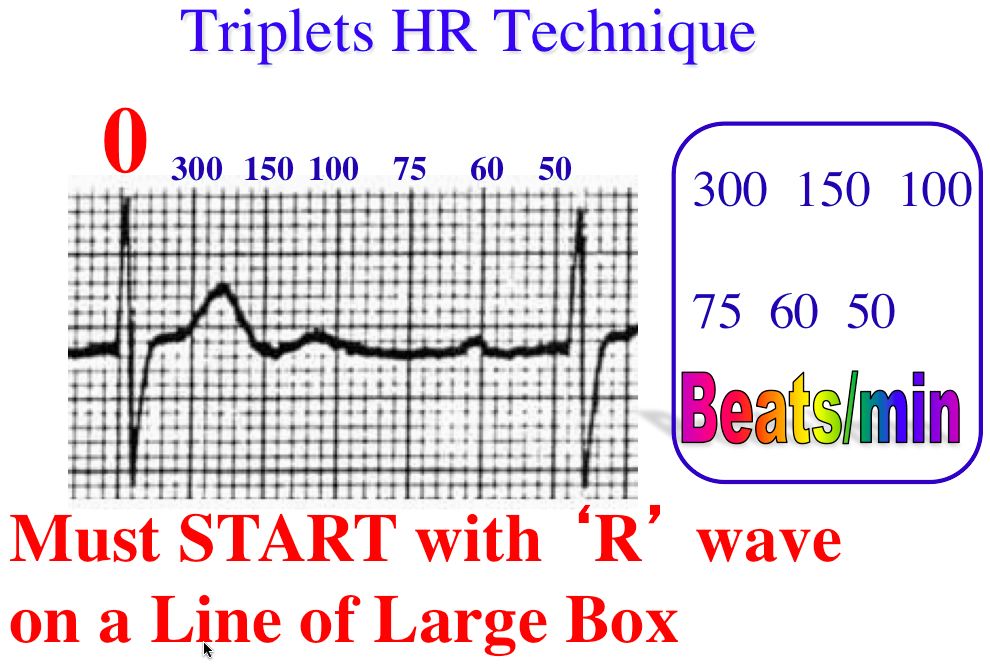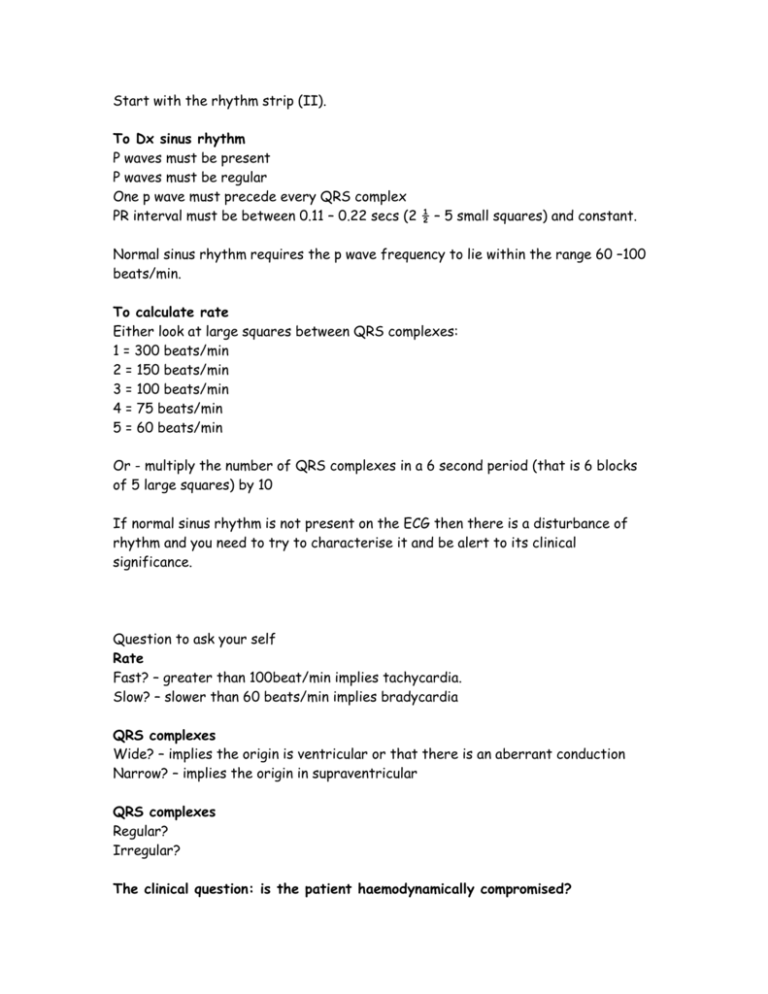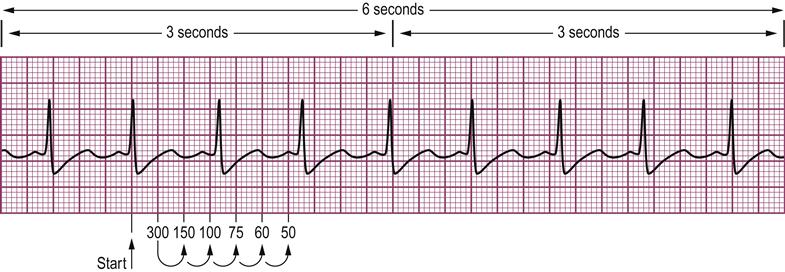• 300 method – 300, 150, 100, 75, 60 Rate • 10 second method • Each EKG is 10 seconds • Count total QRS complexes • Multiply by 6 Rate • Normal 60 – 100 • Bradycardia < 60 • Tachycardia > 100 Rhythm • Sinus •Atrial • Supraventricular • Junctional • VentricularExpressed in beats per minute (BPM) Determining Heart Rate 3step approach (1) Locate R wave that falls on or near thick line (2) Count # of thick lines until next R wave (3) Use "" rule Memorize the following sequence of numbers as stated in the ECG Strip Ease Book, "300, 150, 100, 75, 60,50 4" Start with the pwave or rwave (according to which rate you are measuring) closest to a heavy line on the EKG paper Assign the next series of heavy lines the six numbers respectively

Ecg Rate Flashcards Quizlet
Ecg 300 150 100 75
Ecg 300 150 100 75- Use the sequence Count from the first QRS complex, the first thick line is 300, the next thick line 150 etc Stop the sequence at the next QRS complex When the second QRS complex is between two lines, take the mean of the two numbers from the sequence or use the finetuning method listed belowTwo large squares, 150 bpm, three large squares, 100 bpm, four 75 bpm




Heart Rate The Premier Ekg Resource For Medical Professionals Ekg Md Dr Anthony Kashou
Use the following numbers to indicate what the heart rate is between two successive R waves 300, 150, 100, 75, 60, 50, 43, 37, 33, 30 Method # 2 The Six Second Tracing Method Obtain a six second tracing (30 five mm boxes) and count the number of R waves that appear within that 6 second period and multiply by 10 to obtain the HR/minFor example if there is 1 large square between R waves, the heart rate is 300 bpm;The mnemonic "" to estimate the rate in beats per minute (BPM) In other words if you pass 2 lines before the next QRS, the heart rate (HR) would be less than 150 Remember that this is merely an estimate
Normal ECG Standard 12 Lead ECG 12 Lead ECG record Role of Conduction System 12 lead ECG Limb leads I a VR II III Precordial leads V 1 V 4 a VL V 2 V 5 a VF V 3 V 6 Rhythm strip 300 150 100 75 6050 43 Standard 12 lead ECG 25 mm/sec 1 mv/10 mm 10 sec !!Using the method 300 150 100 75 60 in the above example, 3 large boxes noted between two Rwaves, followed by roughly 25 small boxes would represent a ventricular rate of 85/min Another method is to divide 1500 by the number of small squares between two Rwaves The rule of 300 No of big boxes Rate (apprx) 1 300 2 150 3 100 4 75 5 60 6 50 10 second rule • As most ECG record 10 seconds of rhythm per page, one can simply count the number of beats present on the ECG and multiply by 6 to get the number of beats per seconds
심박동 계산법 빨간 구름이 1개씩 늘어날 때마다 300, 150, 100, 75, 60 4Axis Lead I, aVF 의 R 파를 벡터로 보고 벡터의 합으로 축을 확인 합니다 아래 그림에서 심장의 축이 The HR may be counted by simply dividing 300 by the number of the large squares between two heart beats (RR) If the interval between two beats is one large square, the HR is 300 beat/min, 2 squares →150, 3 squares →100, 4 squares → 75, 5 squares → 60, 6 squares → 50 beat/min Figure 1 Calculating heart rate on EKG sheet, HR ~ 1 2EKG Intermediate Tips, tricks, tools Brian Gober, MAT, ATC, NRP, CSCS sequence Count from the first QRS the first thick line is 300, the next thick line 150 etc Count the number of QRS complexes that fit into 3 seconds Rate ECG Rate Ruler Regularity Determining regularity is the second step of analyzing



Large Block Method To Calculate Heart Rate Ecg Medical Training




Ecg Basics Methods Of Heart Rate Calculation Youtube Nursing School Notes Nursing School Survival Nursing Notes
Vertical axis is electrical HQHUJ\ (mV) 43 Normal Sinus Rhythm What is the heart rate?Divide the number of large boxes into 300 This method is only recommended for regular rhythms 300, Select one 60 75 Movement 50 150 Tremors , 100, Select one 60 75 Movement 50 150 Tremors , 60, Select one 60 75 Movement 50 150 Tremors1st R 300 150 100 75 60 50/min Heartrate measure 2 cardiac cycles 0 1 86 67 55 Maximal QTc per given heart rate what QT value at what heart rate results in a QTc of 450ms?




How To Find Heart Rate Pulse From Ekg Youtube




Ecg Basics Methods Of Heart Rate Calculation Youtube
Use that as the start Rwave and then count success big boxes from the start as 300, 150, 100, 75, 60, 50 Below 50, use the formula given in method #2 This method is good for regular rhythms Method #2 300 divided by the number ofThe 300, 150, 100, 75, 60, 50 method can be used to determine the ventricular heart rate but not the atrial rateRate, rhythm and axis from an ECG 1)Rate The ECG paper runs at 25 mm/sec through the ECG printer Use the sequence Count from the first QRS complex, the first thick line is 300 bpm, the next thick line 150 etc Stop the sequence at the next QRS complex




Ecg




Triplets R To R 6 Second Heart Rate Method
300 150 100 75 60 250 214 187 167 136 125 115 107 94 79 71 68 65 62 START Rapid Interpretation of EKG's by Dale Dubin, MD COVER Publishing Co, 300, 150, 100, 75, 60, 50, 43, 37, 33 The heart rate irregular rhythm If the heart rate is irregular, count the number of QRS complexes on the ECG and multiply by 6 to obtain the average heart rate The ECG paper will show a period of 10 seconds300 150 100 75 60 250 214 187 167 136 125 115 107 94 79 71 68 65 62 START "300" "150" "100 Rapid Interpretation of EKG's by Dale Dubin, MD COVER Publishing Co, PO Box , Fort Myers, FL , USA 1




Start With The Rhythm Strip Ii




How To Compute The Rate Youtube
One of the most important parts of EKG interpretation is comparing the current EKG with any previous EKGs available "300, 150, 100, 75, 60, 50300 150 100 75 60 50 43 2 Rate greater than 100 bpm ECG Criteria Rate greater than Sinus tachycardiaSinus tachycardia • มกเัป นการสสสนองตอบทางสรระของรางกายตามี ปกติไมจาเ ํป นตองรกษา ัจาเพาะํThe dark vertical lines correspond to 300, 150, 100, 75, 60, and 50 bpm For example, if there are three large boxes between R waves, the patient's heart rate is 100 bpm There are more accurate ways to determine heart rate from ECG, but in lifesaving scenarios, this method provides a




Cardiac Arrhythmias And Conduction Disturbances Musculoskeletal Key



Co Grand Co Us Documentcenter View 636 Heart Rate Fast And Easy Ecgs Shade Wesley



0 件のコメント:
コメントを投稿